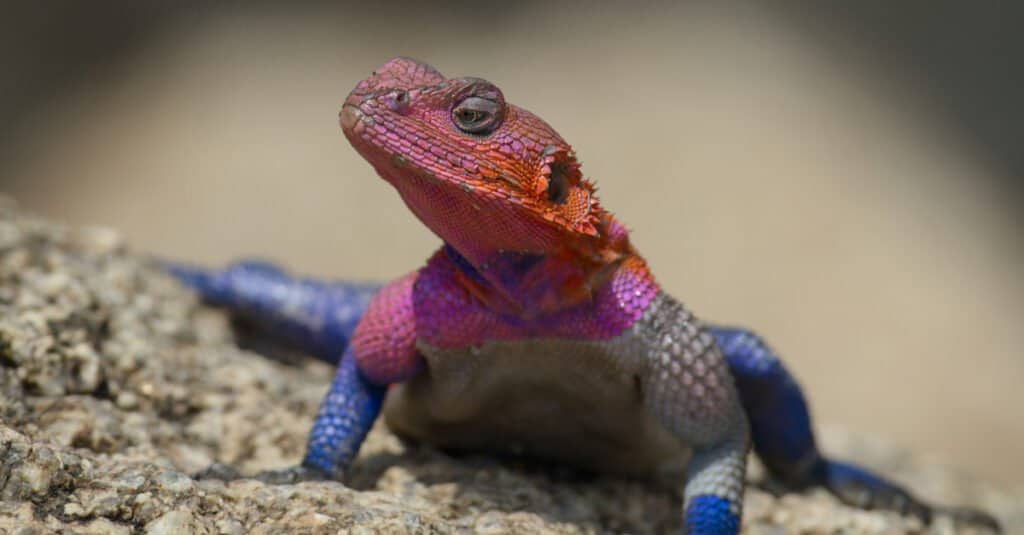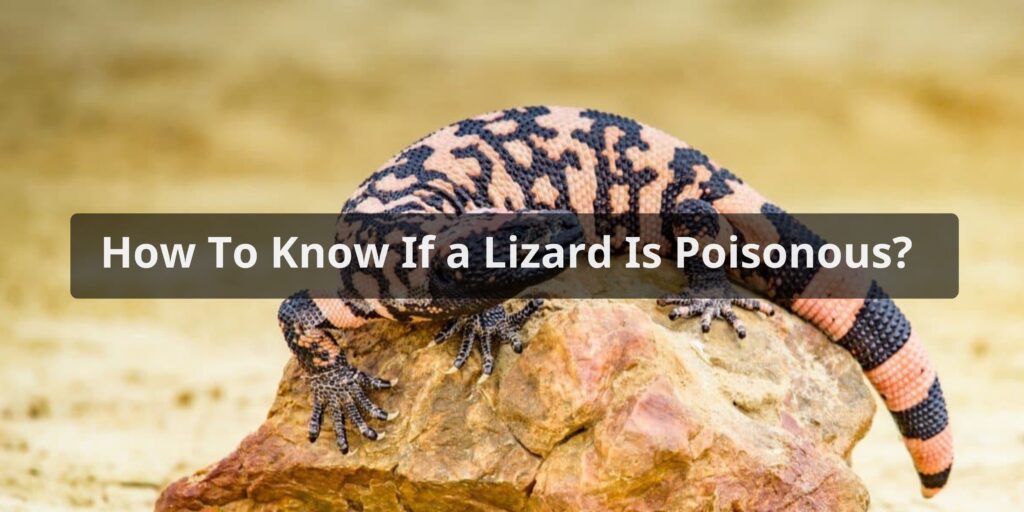Lizards are found all over the world in many different habitats. While most lizard species are harmless, some can be venomous or poisonous. Knowing how to identify potentially dangerous lizards is important, especially if you live in an area with venomous species. Here is a guide on how to know if a lizard is poisonous.
Look for Physical Signs
Certain physical features can help identify venomous lizards. Watch out for the following:
Fangs or Teeth
Venomous lizards like the Gila monster have fangs, grooves, or enlarged teeth to deliver venom. The teeth are located at the front of the upper jaw. If you see a lizard with distinct fangs, teeth, or oral scales, treat it as venomous.
Triangular-Shaped Head
Many venomous lizards have wide, triangular-shaped heads. This allows space for the venom glands. Monitor lizards and Gila monsters have noticeably wide, triangular heads compared to harmless lizard species.
Bright Colors

While not universally true, many venomous lizards are brightly colored. Vivid reds, oranges, greens, or patterns like bands or stripes may signal toxicity. Bright colors can warn predators to stay away. Non-venomous lizards more often rely on camouflage.
Stocky Build
Venomous lizards tend to be stockier with shorter legs and tails compared to harmless species. They rely on venom for defense over running away or dropping their tail. A heavyset lizard body type often indicates toxicity.
Consider Behavioral Signs
Observing how a lizard behaves can also offer clues about venom risks:
Aggression
Venomous lizards tend to be more aggressive when threatened. They may hiss, puff up their bodies, jerk their heads, or chase after a threat. This confrontation behavior contrasts harmless lizards that flee or remain still to avoid detection.
Habitat
Note where you encounter a lizard. Venomous species tend to live in dry, desert-like habitats. Monitor lizards and Gila monsters native to the American Southwest inhabit arid areas. Tropical lizards are less likely to be venomous.
Activity Time
Many venomous lizards are nocturnal or crepuscular (active at dawn/dusk). They avoid daytime heat. If you see a lizard active at night, treat it with added caution. Diurnal activity doesn’t guarantee safety though—the Gila monster is an exception.
Movement
Harmless lizards often dart quickly to escape predators. Venomous species feel less pressure to flee rapidly. Slow, deliberate movements can signify a venomous lizard.
Be Familiar with Venomous Species
Learn which venomous lizards may inhabit your region. Key venomous species worldwide include:
- Gila monster – Found in the southwestern United States and northwestern Mexico. Slow-moving with a black and pink/orange coloration.
- Mexican beaded lizard – Closely related to Gila monsters and found in west-central Mexico. Distinctive beaded look with black and yellow markings.
- Monitor lizards – General name for several large Old World species including the Nile monitor, Argus monitor, and lace monitor. Often have yellow, green, or gray patterning.
- Komodo dragon – The largest lizard at over 3 meters long. Limited to a few Indonesian islands. Stocky build with tan and grey markings.
- Lace monitor – Found across northern Australia and parts of Southeast Asia. Grows over 2 meters long with yellow and black bands and a blue tongue.
- Garter snakes – Mildly venomous rear-fanged snakes common across North America. Have vibrant stripes in colors like red, yellow, and blue.
Knowing your regional venomous lizards allows quicker identification and risk assessment. Be wary of any lizards matching dangerous species’ descriptions.
When in Doubt, Keep Your Distance
If uncertain whether a lizard poses a venom risk, err on the side of caution and keep your distance. Never try to touch or capture the animal. Simply leave the area and allow the lizard to retreat. With careful observation and awareness, it is possible to appreciate these reptiles safely. Monitor children and pets when venomous species are present. Prompt medical care can treat the rare lizard bites that occur.
Conclusion
Identifying a poisonous lizard takes a trained eye, but basic physical traits, behaviors, habitats, and knowledge of regional species offer tells. Venomous lizards often have distinct teeth, head shape, colors, build, movements, and confrontation tendencies compared to harmless varieties. When in doubt, admire lizards from a safe distance rather than risking a bite. Staying alert and informed allows coexistence with these unique reptiles.
FAQs About How to Know if a Lizard is Poisonous
Are brightly colored lizards usually poisonous?
Not necessarily. While bright colors can be a warning sign in nature, not all brightly colored lizards are poisonous. Some use coloration for mating or camouflage. Reliable identification involves considering color patterns, habitat, and specific markings rather than solely relying on color to determine toxicity.
Do all venomous lizards have noticeable fangs?
No, not all venomous lizards have easily noticeable fangs. Some venomous lizards have grooves or channels in their teeth through which venom flows into their prey. Fangs might not always be prominent, making it important to consider other characteristics like behavior, habitat, and venom delivery mechanisms.
Can I identify a poisonous lizard by its size?
Identifying a lizard’s toxicity solely by its size isn’t reliable. Venomous and non-venomous lizards can vary greatly in size. It’s essential to examine other features such as color, pattern, behavior, and geographic location. Consulting field guides or experts can help differentiate between species based on multiple factors.
What behaviors might indicate lizard toxicity?
Certain behaviors might indicate lizard toxicity. Lethargy, unprovoked aggression, hissing, or exaggerated defensive displays can be signs of a potentially venomous lizard. However, behavior alone isn’t a foolproof indicator, as non-venomous lizards can also exhibit defensive behaviors. Multiple factors should be considered for accurate identification.
Are there regions where venomous lizards are common?
Yes, venomous lizards are more commonly found in certain regions. For instance, many venomous species are prevalent in parts of Australia and North America. These regions often have specific ecological conditions that favor the development of venomous species. Local field guides and experts can provide information about venomous lizards in specific areas.



